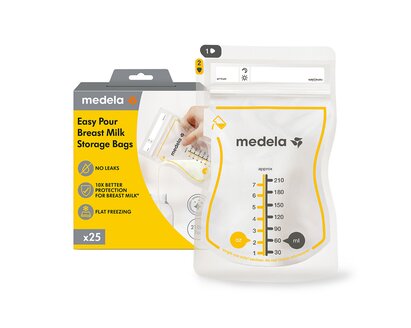Oxytocin: The “Cuddle Hormone”
As your baby breastfeeds, your body produces oxytocin, a hormone that impacts your body in a number of ways. First of all, oxytocin triggers the milk ejection reflex, also known as “let-down.”
Some mums actually feel the milk letdown happening as the cells around your milk glands contract and squeeze the milk out.
Oxytocin, released during breastfeeding or expressing, also helps the uterus contract and return to its normal size and shape.
Finally, oxytocin is considered a socializing hormone that helps us form relationships with others.
Oxytocin is produced by both mum and baby and is further transferred to baby in mum’s breastmilk. It is stimulated by either breastfeeding or expressing and skin-to-skin contact.
Oxytocin is also produced in dads when they play with their baby and have skin-to-skin contact and helps dad bond with baby too.
Prolactin
Prolactin is another important hormone in breastmilk feeding. You start producing it during your pregnancy, but high levels of oestrogen and progesterone in your bloodstream counteract its effects.
When you give birth, the levels of oestrogen and progesterone suddenly drop off. That’s when prolactin can start doing its job and stimulate the production of breastmilk.
It is the levels of prolactin in the body that allow breastmilk feeding to continue. That is why it is so important to initiate breastmilk feeding within 30 minutes to an hour after your baby is born. Prolactin levels drop between feedings, but every time your baby breastfeeds, or you express, the levels increase, signalling the body to make more breastmilk.
A Clever Little Thing Called FIL
Feedback Inhibitor of Lactation or FIL for short, is a substance thought to be contained within breastmilk. It knows when your breasts are full or have recently been emptied and helps to regulate the amount of milk you make.
If your baby is feeding regularly and draining the milk well, then FIL keeps sending messages to the cells to “fill” the breast with milk again. This is a process known as supply and demand. So, when the breasts are emptied regularly the breastmilk is refilled regularly.
FIL also plays a role when the breast is not emptied frequently enough. If you or your baby no longer feed regularly, the breast is not being emptied as often as before. As the breast gets fuller and fuller of milk which you are no longer feeding to baby, FIL sends messages to eventually reduce and then stop the cells from making more milk.
After a few days this "feed" will disappear and your milk supply will have reduced. This is a clever protection method to prevent your milk cells from getting damaged by being too full, but also results in reducing milk supply. This is essentially how weaning works.
If you keep reducing the number of feeds then your body keeps reducing the milk supply it makes available in the breasts. This is supply and demand too; reduced demand for the milk leads to less milk supply.
If a mum has mistakenly reduced her milk supply by taking out a usual breastfeed or by introducing a formula bottle feed and has now found that her milk supply has reduced, she can still increase her milk supply back again.
By reintroducing the breastfeed or expression she originally took out and increasing “demand” to the breasts again, she will notice that within a few days of feeding more frequently the body will be supplying more milk. Supply and demand is simple when you understand it!
The breasts also work independently of each other too! For example, if for some reason a baby started to only breastfeed on the left breast and stopped feeding off of the right breast, then there would be no demand for milk from the right breast. The FIL would then shut down the milk making cells in the right breast.
As the “demand” was still regular in the left breast it would continue making milk in the left breast. This is how some women can fully breastfeed from just one side. How wonderful are our clever, energy saving and genius breasts!
Here’s a look at some of the types of breast milk…
Colostrum
A low-fat, high-protein, yellowish milk full of antibodies, leukocytes, stem cells, and a myriad of other things that coat and protect baby’s digestive tract. Colostrum is produced in very small, concentrated quantities to accommodate the tiny tummies of newborn infants.
Besides providing nutrition and protecting baby from infections, colostrum’s laxative properties also help him to pass his first stools.
In fact, colostrum is so complex that we are still just scraping the surface when it comes to discovering all of its amazing properties and benefits for babies.
Once your milk has come in, the mature breastmilk you produce can be divided into 2 distinct types: foremilk and hindmilk.
Your breasts don’t actually produce 2 different kinds of milk; however, the fat content in the milk depends on how long the milk has been sitting in the ducts.
Foremilk: Thinner and Low in Fat
When your baby starts feeding he receives the lower-fat, higher-lactose foremilk. This milk is important for quenching your baby’s thirst and providing him with the energy he needs now.
Hindmilk: Thicker and High in Fat
As a breastfeeding session on one breast continues, your baby will start to receive the high-fat hindmilk that keeps him feeling full and provides the energy he needs to grow.












































